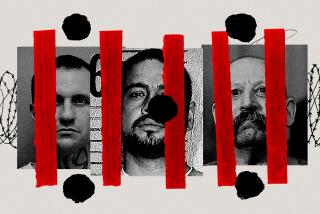A New Theory on Fate of One of Russia’s Last Royals : Books: Writer Edvard Radzinsky believes that Crown Prince Alexei survived the attack that killed his family, and spent years in a Soviet asylum.
- Share via
NEW YORK — For more than 70 years, Russian monarchists have fantasized that Romanov Princess Anastasia survived the Bolshevik assassination of Czar Nicholas II and his family and escaped to the West.
Now writer Edvard Radzinsky’s obsession with the last days of the doomed czar has uncovered a new twist: a theory that 14-year-old Crown Prince Alexei lived through the hail of bullets on July 16, 1918, and spent years in a Soviet asylum after World War II.
“I have strong evidence that two of the Romanovs survived the execution,” Radzinsky said in an interview here to discuss his new book, “The Last Tsar,” released this month by Doubleday.
Radzinsky, a playwright and historian in Moscow who has spent 25 years researching the matter, bases his conclusions on two areas of evidence.
One is a series of reports by the killers--discovered in the newly opened archives of the old Soviet Union--hinting that Alexei may not have died. The other is research into the background of a Soviet psychiatric patient who bears startling similarities to Alexei.
Except for royalist romantics who cling to their belief in the survival of Anastasia, the czar’s youngest daughter, most people believe the 300-year Romanov dynasty ended when Lenin’s henchmen herded Nicholas and his family into a basement room of a house in Ekaterinburg and gunned them down.
Nicholas fell immediately, followed by his wife, Alexandra Feodorovna, their doctor and three servants, according to the reports.
Alexei fell wounded, but the princesses--Anastasia, Olga, Tatiana and Marie--ran about the room screaming as the killers fired volley after volley.
“The bullets from the revolvers bounced off for some reason and ricocheted, jumping around the room like hail,” the leader of the assassins, Yakov Yurovsky, wrote.
Even Alexei, a sickly hemophiliac, would not die. Yurovsky recalled “the strange vitality of the heir.”
The killers bayoneted the girls, but were thwarted by their bullet-proof, diamond-lined corsets: “The bayonet was like a dagger, but it was dull and would not penetrate. . . . Later they got (one) with their rifle butts,” another assassin, Alexei Kabanov, wrote.
The Bolsheviks stripped the bodies and found 18 pounds of diamonds sewn into the clothing of the children.
Radzinsky believes Alexei and Anastasia may have been saved by their million-dollar garments.
Another assassin, Andrei Strekotin, said that after the shooting, the bodies were taken to a truck. The daughters turned out to be alive, he said.
“We couldn’t shoot anymore--with the open doors, the shots could have been heard in the streets,” he said.
Some of the Red Guards taking the bodies away for burial, knowing that the approaching White Russians would kill them for their roles in the affair, may have found Alexei and Anastasia still alive and slipped them off the truckload of bodies, hoping to barter them for their own lives, Radzinsky believes.
Radzinsky noted that in 1979, when scientists found the grave of the 11 people shot that night, “only nine skeletons were found--two of the bodies were missing.”
The legend that Anastasia escaped was born in Berlin in 1920, when a depressed young woman tried to commit suicide by jumping into a canal.
When she recovered from amnesia, she called herself Anastasia and continued to do so for years. She lost a legal attempt to claim the daughter’s name as her own.
Radzinsky believes that he may have discovered the fate of the 11th person--Alexei.
His research led him to testimony from a psychiatrist and 1949 hospital records concerning a dignified patient who insisted that he was the son of Nicholas II.
The man had noble manners and knew the rooms of the Winter Palace and country residences, and the czar’s relatives and lineage.
He claimed, the doctors said, to have been rescued the night of the slaughter. He changed his name to Filipp Grigorievich Semyonov, served in the Red Army and became an economist. He claimed a Bolshevik knew his secret and was blackmailing him.
Like the Crown Prince Alexei, Semyonov was hemophiliac. A Soviet doctor ordered a private examination.
“The patient had a cryptorchidism (one testicle had not descended), which the consultant knew had been noted in the dead heir Alexei,” the doctor said.
Semyonov was given a choice of accepting a diagnosis of paranoia and being sent to a labor camp or facing further interrogation.
“If they announced that he is not crazy, he would have been immediately shot. It was Stalin’s time,” Radzinsky said. Semyonov accepted the label of “psychotic” and was interned.
Labor camp inmates wrote to Radzinsky to say that the prisoner named Semyonov was released in 1964 and died shortly afterward, asserting to the end that he was the Crown Prince Alexei.
More light may be shed on these mysteries later this month.
American forensic experts plan to examine the remains found where the assassins said they dumped the bodies.
In October, American scientists plan to compare the skulls with photographs of the Romanov children when their heads were shaved a year before the killings to relieve measles symptoms.
The pictures may provide more evidence of whether Anastasia and Alexei were buried with their family.
More to Read
Sign up for our Book Club newsletter
Get the latest news, events and more from the Los Angeles Times Book Club, and help us get L.A. reading and talking.
You may occasionally receive promotional content from the Los Angeles Times.






